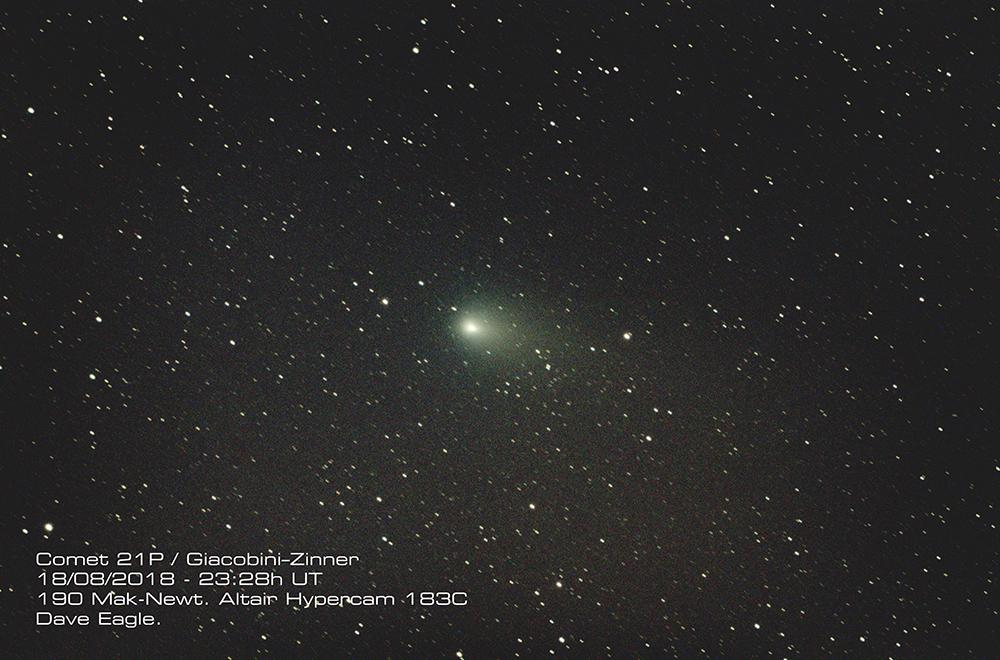The most recent LORRI images downloaded from New Horizons during the flyby of Ultima Thule will be posted on this Web Site:
http://pluto.jhuapl.edu/soc/UltimaThule-Encounter
Enjoy!
Dave
The most recent LORRI images downloaded from New Horizons during the flyby of Ultima Thule will be posted on this Web Site:
http://pluto.jhuapl.edu/soc/UltimaThule-Encounter
Enjoy!
Dave
My free monthly sky diary for January 2019 showing the events of the night sky visible from the UK is now available in a printable pdf version for download.
Click here, or on the image below to download the pdf.
I also have the sky diary to share available on Google calendars.
Click here to go to my Google calendar.
More events will be added to the live Google calendar as more information becomes available.
Don’t forget to watch the results and images coming back from New Horizons as it whizzes past the Kuiper Belt object Ultima Thule on New Years Day.
Click on the link below for more details:
http://www.star-gazing.co.uk/WebPage/new-horizons-ultima-thule
For a printable version of this page, CLICK THIS LINK.
Another comet of interest was discovered on the 18th of December by Japanese astronomer Masayuki Iwamoto.
Comet C/2018 Y1 (Iwamoto) is a fast-moving comet passing closest to Earth around the 11th of January. It will still be at least 28 million miles from Earth at it’s closest.
It’s estimated maximum brightness will be between +7.5 and +8.9. Although not that bright, it should be easily visible in binoculars or a small telescope and make a great photographic subject.
The chart below shows the path of the comet against the star background over the next 3 months.
The map below shows the comet’s path during the first part of January until the beginning of February.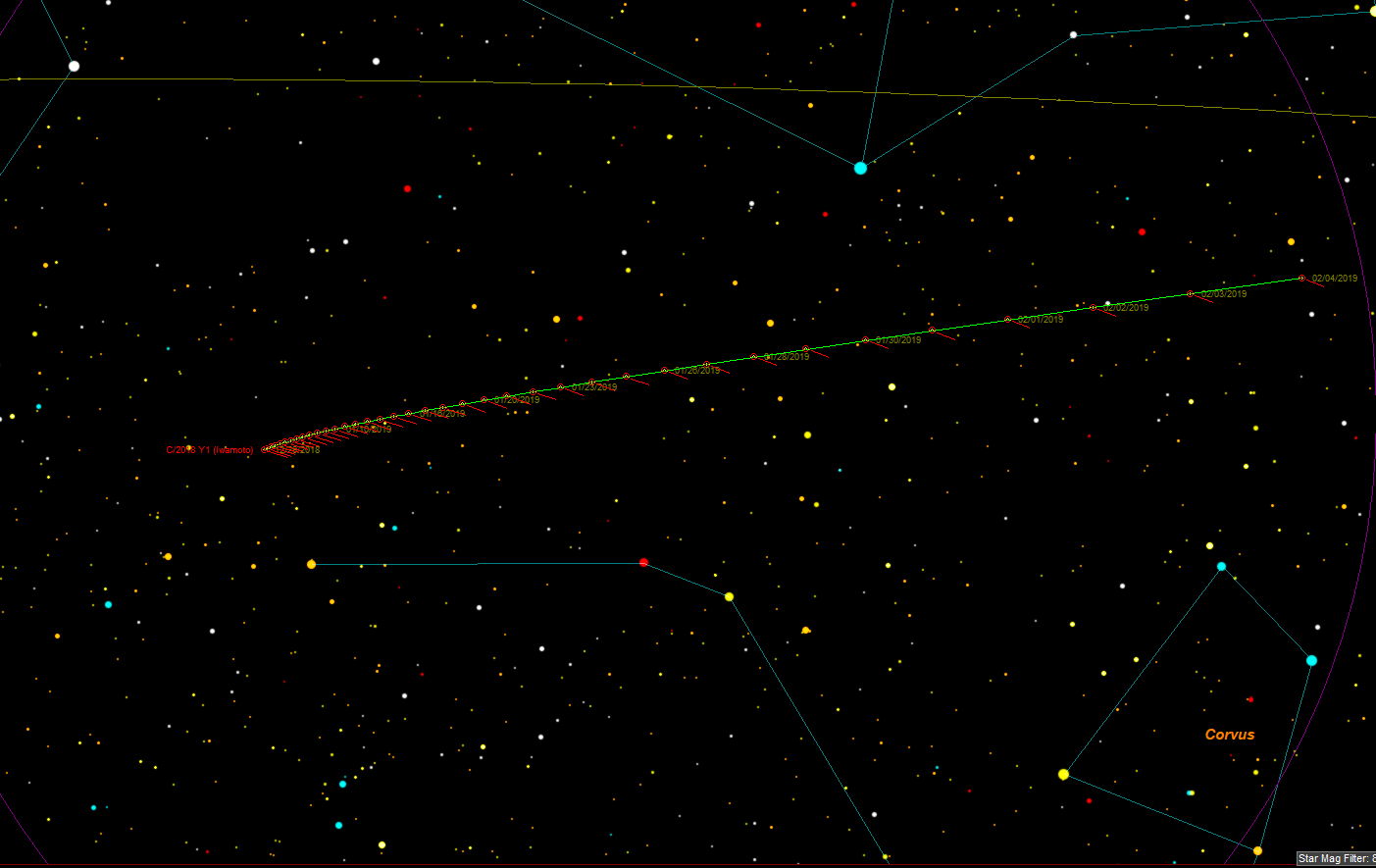
The map below shows the path of the comet throughout January, into February.

On the 3rd of February, the comet passes a couple of degrees north of The Sombrero Galaxy Messier 108.
On the 10th and 11th of February the comet will pass fairly close to the three Messier galaxies, M95, M96 and M105.
This will make a great photographic opportunity, especially as the comet will be at its brightest but it will be moving at its quickest around this time. The Moon will be just before 1st Quarter, so stay up late into the early hours after Moonset when the comet is high in the sky.
On the 12th of February, the comet will by now have moved considerably and will lie fairly close to the bright +3.6 magnitude star Eta (η) Leonis, situated within The Sickle of Leo.
The Moon will be at First Quarter on this evening.
Passing through the northern part of Cancer mid-February, by the 18th of February the comet will be found close to the 1st magnitude star Castor in Gemini, making it very easy to find.
This map shows the path of the comet towards the end of February into March 2019.
By the 27th of February, the comet, now fading considerably, will have moved into Auriga. It passes between the bright open clusters M38 and M36 on this date, making another great photographic opportunity. The Moon will be just after last quarter this day, so will not rise until the early hours.
How this comet will actually perform and how bright it might become is anyone’s guess.
After all, it is a comet.
The only way to tell for sure is to out there and enjoy this new comet and whatever it brings us.
Dave
For a printable version of this page, CLICK THIS LINK.
If the political climate and government department shut-downs in the United States continue, NASA TV will not be operating on New Years Day.
This is of course the day that New Horizons is shooting past its next target way out in the Kuiper Belt; The Ultima Thule Flyby.
Click HERE or on the image below to download the press kit.
If NASA TV isn’t back up and running by then, live images and data streaming back from the probe on the day will not be broadcast.
Luckily there are other ways of us being able to keep up with this.
Live coverage will be streamed via that Web site.
The schedule of the webcasts is below:
Friday 28th December, 2018
18:00 – 18:30 GMT (1:00-1:30 pm EST)
New Horizons: Beyond Pluto. Preview of the spacecraft and science operations during the Ultima Thule flyby.
Monday 31st December, 2018
19:00 – 20:00 GMT (2:00-3:00 pm EST)
Press briefing: Ultima Thule flyby science and operations preview
20:00 – 21:00 GMT (3:00-4:00 pm EST)
Q&A: Ask the New Horizons Team
01:00 – 04:00 GMT (8:00-11:00 pm EST)
Panel discussion on exploration of small worlds (01:00 – 02:00 8 – 9 pm EST); Ultima Thule flyby countdown events; mission updates
Tuesday 1st January, 2019
05:15 – 05:45 GMT (12:15-12:45 am EST)
Live coverage of countdown to closest approach (12:33 am); real-time flyby simulations
14:45 – 15:15 GMT (9:45 – 10:15 am EST)
Live coverage of New Horizons signal-acquisition from Ultima Thule flyby
16:30 – 17:30 GMT (11:30 am– 12:30 pm EST)
Press briefing: Spacecraft status, latest images and data download schedule
Wednesday 2nd January, 2019
17:00 – 18:00 GMT (2:00-3:00 pm EST)
Press briefing: Science results from Ultima Thule
Thursday 3rd January, 2019
19:00 – 20:00 (2:00-3:00 pm EST)
Press briefing: Science results from Ultima Thule
To make sure everyone can join in the excitement, Alan Stern, Principle Investigator for New Horizons, is determined to keep us all as informed as much as possible so will be streaming and posting as many ways as possible.
John Hopkins University Applied Physics Laboratory will be webcasting live on their Youtube Channel: https://www.youtube.com/user/jhuapl
Alan will also be posting results on social media, so keep up to date with this exciting encounter by following him here:
Twitter: https://twitter.com/AlanStern
Facebook: https://www.facebook.com/s.alan.stern
Comet 46P/ Wirtanen is at it’s closest to Earth this weekend.
It’s supposed to be naked eye, but I’ve so far failed to see it without optical aid. It is now easily visible in 10×50 binoculars. The Coma is a bit bigger than the apparent size of the full Moon. In 15×70 binoculars the full extent of the coma can be seen and it is HUGE!
Despite what the popular media say, it’s not going to be spectacular, or dazzling.
This weekend it will be conveniently located smack bang between the Hyades and Pleiades star clusters in Taurus, so will be fairly high up in the sky late evening.
To make the most of this opportunity to see it before the Moon gets even brighter, free maps of it’s position are available to download from my Web site:
http://www.star-gazing.co.uk/WebPage/comet-46p
Enjoy!
Dave
Comet 46P – 13th December 2018.
72mm refractor and Nikon D750 DSLR.
So! Comet 46P / Wirtanen (The original target of the Rosetta and Philae mission) is huge!
It’s apparent size is a little over 1°, making it larger than the apparent size of The Moon (or Sun).
It is also supposedly bright enough to be a naked eye object.
But being so big, it’s light is spread out over a wide area of sky, making it a bit more difficult to make out, especially if you have some light pollution, like me.
It’s not visible from my location with the naked eye, but it is just about visible in my 10×50 finder scope. Very extensive and faint, a bit like Messier 33 in Triangulum.
A pair of 15×70 binoculars really do it more justice, showing it much brighter and just how extensive the coma reaches out from the pseudo nucleus.
Here’s an image I took on the 9th of December.
Using the subs I took, I also made an animation showing the movement of the comet during the duration of the imaging session.
Travelling northwards (that makes a change!), 46P will at its brightest on the 17th of December.
At this time it will be located between The Hyades & The Pleiades in Taurus, so will be very easy to find.
Click here to download my guide for Comet 46P.
How big is the Coma? I have made a composite image showing the Comet against M42, The Orion Nebula. Both images taken with the same setup on the 8th of December.
While I was in the area, I wanted to do some more comet fun, so I wandered up to catch Comet 64P / Swift-Gehrels, which was just starting to cut across the constellation of Triangulum that evening.
It’s a lot smaller and fainter, at about 10th magnitude, but is still showing up very nicely in the image.
Just before I finished, I pointed the telescope towards Mars so I could capture Neptune close to it before they move too far apart from one another. Here’s the result.
All images taken using a 72mm refractor and a Nikon D750 DSLR.
Comet 64P’s path for November and December is below.
(Click on the map for a bigger view)
For a black on white printable version, Click Here.
My free monthly sky diary for December 2018 showing the events of the night sky visible from the UK is now available in pdf form to download and print.
Click here, or on the image below to download the pdf.
I also have the sky diary to share which is available on Google calendars.
Click here to go to my Google calendar.
My guide to viewing Comet 46P Wirtanan, which is now a naked eye object and at its best this month, is also available here:
http://www.star-gazing.co.uk/WebPage/comet-46p
More sky events will be added to the live Google calendar as more information becomes available.
On Monday the 12th of November, will returning to Knowle Astronomical Society, in Solihull, to present:
Rosetta & Philae: From Concept To Reality

I am stepping in at the last minute, as their arranged speaker has unfortunately let them down at short notice.
My presentation includes the conclusion of this spectacular mission to Comet 67P – Churyumov-Gerasimenko, right down to its final image before it “crash” landed on the comet’s nucleus, plus some of the latest findings that have recently been published.
Courtesy of Dr Colin Snodgrass from the Open University, there is a chance for the audience to sniff Comet 67P. I will be collecting opinions on what the audience think it smells like.
Thanks to a 3D printed model, they can also get a really good feel for what the comet looks like.
So, if you’re in the area, come along, say “Hello” and enjoy my presentation.
I’m really looking forward to catching up with this group again.
Doors open at 7:30pm, Meeting starts around 8:00pm.
Venue:
Dorridge Village Hall,
Grange Road, Dorridge,
SOLIHULL,
B93 8QA.
On Wednesday the 21st of November the Flat Tim fun and games for all ages roadshow will be out once again for my very last evening presentation of the year.
This time it’s another visit to my very good friends at North Essex Astronomical Society.
I shall be inflicting on them my ever popular audience-participation presentation:
“Celebrate Tim Peake’s Principia Mission”.

I am looking forward to meeting up with this group again and catching up with some very good friends.
Like all my other visits out with this presentation, I’m really looking forward to having a lot of fun with this lot during the audience participation bits. I am sure that, like the other groups I have taken this presentation to, they will really enjoy the fun evening @Flat_Tim and I have planned.
All are very welcome, especially kids, as this presentation is aimed at all kids with any level of knowledge, at all ages from 10 – 110.
So bring along your children, grandchildren, parents and grandparents to find out what Tim got up to during his 6-month stay in The International Space Station.
Just come along enjoy the presentation and say “Hello”.
If not to me, then to @Flat_Tim.
I wonder how keen these folks will be compared to some of the other groups about having their selfies taken with him at the end of the evening for me to stick on social media. I can’t wait to find out.
If you can’t make any of my Tim Peake talks, or don’t want to, just make sure that you visit Cardiff to see the Soyuz capsule (TMA-19M) and Sokol KV-2 space suit.
These are currently on display at The National Museum in Cardiff until the 10th of February. Click this link for more details.
There is also a virtual reality space descent simulator which I can tell you is absolutely brilliant.
Click here to see details of Tim’s Soyuz capsule tour.
The Capsule and suit will eventually land back at The London Science Museum next year.
The meeting starts at 8:00pm.
Venue:
Henry Dixon Hall
Henry Dixon Rd
Rivenhall
Witham
CM8 3HR
Anyone is welcome – beginner or expert – and there is no need to pre-book.
A small charge applies to help us cover costs (typically £3 for non-members; £2 for members; U16s free).
Doors open at 7.30pm with the talk starting at 8.00pm.
Note that if you are using satnav system, this postcode may not take you directly to the hall – please check this Google Maps link if you aren’t sure:
http://g.co/maps/kt88j
On Monday the 19th of November I will be once again visiting Wolverhampton Astronomical Society.
I will be taking them on a wild ride, touring from The Earth out to the very edge of our observable universe, hitch-hiking on a ray of light.
Appropriately, the presentation is entitled:
A Whistle-Stop Tour of the Universe (Hitch-Hiking on a Ray of Light).

So let’s hope that they all strap themselves in and brace themselves for a journey that really is out of this world.
Of course, it’s just a really fantastic excuse to show lots of beautiful images of our wonderful universe.
Unfortunately, Flat Tim won’t be attending!
So if you are in the area, come along and say “Hello”.
Wolverhampton AS’ meeting starts at 7:30pm.
Venue:
Highfields Environmental Centre,
Boundary Way,
Penn
Wolverhampton,
WV4 4NT
Comet 38P – Stephan-Oterma
Click here to download a printable pdf version of this page.
This period comet was discovered in 1867, by two observers in Marseilles Observatory.
It orbits The Sun in a 38 year orbit, moving out beyond the orbit of Uranus at Aphelion, perihelion at about the same distance from The Sun as Mars.
This comet reaches perihelion early this month, and will pass about 0.8 Astronomical Units (~74,000,000 miles) from Earth, reaching peak brightness around the 23rd of November.
The comet is currently (8th November 2018) about +10th magnitude but brightening slowly.
It could reach a maximum brightness of +9.5 on the 23rd of November.
The comet is moving in a wide arc just below Gemini, heading north-eastwards towards Lynx by the end of the year. By this time, it will have faded considerably.
Use the map at the bottom of this blog entry to find the comet.
Being so far north, it will be visible for the duration of its apparition.
It certainly won’t be as bright as Comet 46P, which should be very bright in December and is the subject of a separate blog entry:
http://www.star-gazing.co.uk/WebPage/comet-46p
Click here to download a printable pdf version of this page.
Path of comet 38P during January.
On Monday the 12th of November, will revisiting Aylesbury Astronomical Society to present:
Rosetta & Philae: From Concept To Reality

It’s been a while since I last did this presentation which now includes the conclusion of this spectacular mission to Comet 67P – Churyumov-Gerasimenko, right down to its final image before it “crash” landed on the comet’s nucleus, plus some of the latest findings that have recently been published.
Courtesy of Dr Colin Snodgrass from the Open University, there is a chance for the audience to sniff Comet 67P. I will be collecting opinions on what the audience think it smells like.
Thanks to a 3D printed model, they can also get a really good feel for what the comet looks like.
So, if you’re in the area, come along, say “Hello” and enjoy my presentation.
I’m really looking forward to catching up with this group again.
Meeting starts at 7:30pm.
Venue:
9th Aylesbury Scout Hut,
Oakfield Road.
Aylesbury
HP20 1LJ
This Saturday Loughton Astronomical Society will be holding its 50th Anniversary Astronomy Festival in Theydon Bois, Essex. The day is split into two parts: A family morning with a 60-seater planetarium and an afternoon of talks for the seasoned astronomers. A number of trade stands will be in attendance.
I will be there selling my books and getting people to feel and sniff Comet 67P.
Venue:
Village Hall,
Coppice Row,
Theydon Bois,
Essex.
CM16 7ER
My free monthly sky diary for November 2018 showing the events of the night sky visible from the UK is now available in pdf form to download and print.
Click here, or on the image below to download the pdf.
I also have the sky diary to share which is available on Google calendars.
Click here to go to my Google calendar.
More sky events will be added to the live Google calendar as more information becomes available.
The day was bright and clear. The Sun was shining and it looked like it would be a good evening to eventually try and capture a reasonable image of Mars, and do some lunar imaging before it got too full as well. In the end it turned out to be a very productive night (and day).
More of my images are on my Flickr Site:
https://www.flickr.com/photos/eagleseyeonthesky
I was quite busy that day, (life seems to have picked up big time since I “retired”, but I’m certainly not complaining), but after making the regular trip to the post office to send out some books, on the way back I decided to get the scope out that afternoon to see if I could capture Venus in the bright daylight sky. It was only 4 days before the planet reached inferior conjunction (27th October). At the time I was hunting it down, it was just 9° from the Sun, and only about 14° above my horizon.
It was certainly going to be a challenge. Luckily towards the South, there is a gap between the neighbours houses, so I had a bit of a chance. I put the 120mm Evostar refractor onto the mount and centred it on The Sun. Once I knew the light from the Sun was passing centrally through the scope, using the computer, I calibrated the mounts position on the Sun. I then sent the scope to the position of Venus. It took me quite a while to get the scope focused (as I hadn’t viewed the Sun directly) and Venus centred, but when I did, a wonderfully thin crescent presented itself, bubbling and bouncing away in the afternoon atmospheric turbulence. It was extremely bright and so beautiful to see.
After viewing for a short time, I attached my DSLR and captured a few images of Venus, to make sure I bagged at least one image.
Single DSLR Image of Venus. 120mm Evostar refractor.
Once happy I had captured a couple of acceptable images, I removed the camera and attached my ZWO ASIU120MC camera to try and take a better image. Getting the planet focused and centred on the camera chip again was even more challenging. But finally I managed to get the crescent in focus and processed to capture some avi’s. About an hour after I started, I watched as Venus slowly disappeared behind my neighbours house.
Processed avi image of Venus. 120mm Evostar refractor, ZWO ASIU120MC camera.
True to the weather forecast, for once, later in the day the skies stayed clear as the sky darkened. I set myself up near the house, so that I could get on Mars as soon as it got dark. I would have to wait until later when it passed through that gap, had I stayed where the pier is set.
I set my Celestron C11 on the mount and took a number of AVI’s of Mars.
Mars – C11 and ZWO ASIU120MC camera.
This is about the best image I could manage, given the small size of the disk and very wobbly seeing just above the neighbours roof.
By the time I finished on Mars, The Moon was now quite high in the sky, so then concentrated my efforts on imaging that. Despite a large, bright gibbous phase, some nice features were picked out nicely along the terminator.
The very bright crater Aristarchus and Schroter’s Valley.

Craters Pythagoras and Babbage .

Lunar Swirl Reiner Gamma and craters Hevelius and Cavalerius.
Bright ejecta rays around crater Kepler.
Colour saturated ejecta rays around crater Tycho.
On Tuesday the 25th of October, I will be re-visiting Luton Astronomical Society
This time I will be presenting COMETS: Enigmatic and Beautiful Visitors.
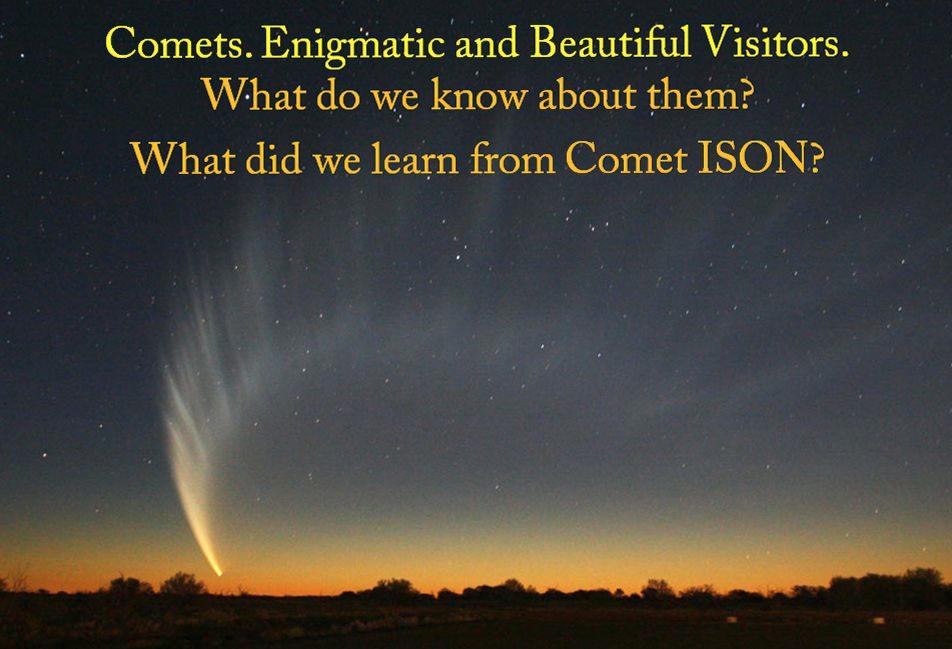
I will be showing at what comets have done to intrigue, terrify and inspire people throughout history.
I will also be looking at what we learnt from all the hype surrounding the apparition of Comet ISON and it’s demise as it passed perihelion as we awaited our long awaited “Comet of the Century!”.
I will also be looking forward to the prospects for incoming Comet 46P/ Wirtanen, which could become a naked eye comet this December.
Luton Astronomical Society meet at:
Putteridge Bury Conference Centre.
Hitchin Road,
Luton
Bedfordshire
LU2 8LE
The meeting starts at 7:30pm.
So if you’re in the area, pop along and say “Hello”.
On Sunday the 21st of October the Flat Tim fun and games for all ages roadshow will be out yet again.
This time it’s another visit to my friends at Rugby & District Astronomical Society.
I’ll be bringing them my ever popular audience participation presentation:
“Celebrate Tim Peake’s Principia Mission”.

I am looking forward to meeting up with this group again.
Like all my other visits out with this presentation, I’m really looking forward to having a lot of fun with them during the audience participation bits.
I’m sure that, like the other groups I have taken this presentation to, they will really enjoy the fun evening @Flat_Tim and I have planned.
All are very welcome, especially kids, as this presentation is aimed at anybody with any level of knowledge, for all ages from 10 – 110.
So bring along your children, grandchildren, parents and grandparents.
Just come along enjoy the presentation and say “Hello”.
If not to me, then to @Flat_Tim.
I wonder how keen they will be compared to some of the other groups about having their selfies taken with him at the end of the evening for me to stick on social media. We’ll soon find out.
Tim’s Soyuz capsule is currently on display at Peterborough Cathedral until the 5th of November. Click this link for more details.
If you can’t make any of my Tim Peake talks, make sure that you visit the Cathedral to see the Soyuz capsule (TMA-19M) and Sokol KV-2 space suit.
There is also a virtual reality space descent simulator which I can tell you is absolutely brilliant. It goes on display in Cardiff from the 15th of November.
Click here to see details of Tim’s Soyuz capsule tour.
The meeting starts at 7:30pm.
Venue:
Church Lawford Village Hall,
School Street,
Church Lawford,
Warwickshire.
CV23 9EE
Click the Google Map link below for more details:
https://www.google.com/maps?ll=52.383449,-1.341121&z=16&t=h&hl=en&gl=US&mapclient=embed&q=52%C2%B023%2700.4%22N+1%C2%B020%2728.0%22W@52.383449,-1.341121
Comet 46P/Wirtanen is getting brighter, and heading northwards.
Now Naked Eye (Apparently!).
Comet 46P taken from home – 13th December 2018.
72mm Altair refractor and Nikon D750 DSLR.
Click this link to download a printable version of the information on this Web page.
This periodic comet is going to reach perihelion, (closest to the Sun), and closest to The Earth (only 7,220,000 miles distant) and at its brightest on the 16th of December.
At this time it is predicted to be around 3rd magnitude and close to the Pleiades Star Cluster. If the prediction turn out to be correct (How often are they?), the comet could easily become an easy naked eye object around this time.
Comet 46P has an orbital period of 5.4 years and the solid nucleus has a diameter of about 1.2 km.
Comet 46P was the original target for the Rosetta and Philae mission.
The target was changed to Comet 67P/Churymov-Gerasimenko when the launch of Rosetta was delayed after the Ariane rocket failure in 1996.
Here are the circumstances of this years apparition.
You can follow progress on the Facebook Page dedicated to the comet:
https://www.facebook.com/46PWirtanen/
46P is currently in the constellation of Fornax, low down in the southern sky in the early around midnight. Currently about magnitude 10, it is challenging from the UK, being so far south.
It is currently heading south, but by the second week in November, it then starts heading north. From this point onward, it will start to pick up speed as the distance from the Sun and Earth decreases.
Path of Comet 46P during November and December 2018.
Click on the map for a better view.
By the first week of December, the comet is within the stars of Cetus and now moving even faster northwards, brightening all the time.
The Moon will be New on the 7th, so will be well out of the way at this time.
Path of Comet 46P during December.
The comet moves swiftly into Taurus mid-December and should now be starting to get very bright.
On the 16th of December, at the time of it’s brightest, at magnitude 3(?), it is nestled very nicely between the Hyades and Pleiades star clusters. We hope it will be a nice naked eye object at this time. The Moon will be a day after 1st Quarter at this time, so will be setting well before midnight, so should not disrupt the view once it sets.
Close up view of 46P’s path around Perihelion.

The comet continues to head northwards, into Auriga, passing through the triangular asterism of “The Kids” on the 22nd of December.
The Moon will unfortunately be full at this time, so will tend to wash out the comet.
It passes the first magnitude star Capella on the 23rd and 24th.
The gibbous Moon in the morning sky will now disrupt observations until the second week of December.
The comet’s apparent motion will have started to slow down a bit now and should have started to fade in brightness, but hey, post-perihelion, anything could happen…
By the end of the year, the comets pace has slowed right down and we find it within the constellation of Lynx.
Path of the comet during January and February 2019.
During January, the comet has slowed right down, faded considerably and now starts a long slow loop as it moves into the head of Ursa Major.
Let’s hope that this comet lives up to all our expectations and gives us a great winter show.
Dave
On Wednesday the 10th of October there will be more Flat Tim fun and games for all ages.
This time it’s a re-visit to Carolian Astronomical Society in Kidderminster.
The title of the audience-participation presentation evening is my ever popular:
“Celebrate Tim Peake’s Principia Mission”.

I am looking forward to meeting up with this group again.
Like all my other visits out with this presentation, I’m really looking forward to having a lot of fun with them during the audience participation bits.
I’m sure that, like the other groups I have taken this presentation to, they will really enjoy the fun evening planned for them.
I wonder how keen they will be compared to some of the other groups about having their selfies taken with @Flat_Tim at the end of the evening.
All are very welcome, especially kids, as this presentation is aimed at any age group, from 10 – 110. So bring your children, grandchildren, parents and grandparents along.
So if you are in the area, come along and say “Hello”.
Tim’s Soyuz Capsule is currently on display at Peterborough Cathedral until the 5th of November. Click this link for more details.
So, if you can’t make any of my Tim Peake talks, make sure that you visit the Cathedral to see the Soyuz capsule (TMA-19M) and Sokol KV-2 space suit. There is also a virtual reality space descent simulator which I can tell you is highly enjoyable.
Meeting starts at 7:30pm.
Venue:
The Science Theatre,
King Charles School,
Comberton Road,
Kidderminster.
DY10 1XA
Tonight, (Thursday the 4th of October 2019) I will be once again visiting Walsall Astronomical Society. I will be taking them on a wild ride, touring from The Earth out to the very edge of our observable universe, hitch-hiking on a ray of light.
Appropriately, the presentation is entitled:
A Whistle-Stop Tour of the Universe (Hitch-Hiking on a Ray of Light).

So let’s hope that they all strap themselves in and get ready for a journey that really is out of this world. (Of course, it’s really just a fantastic excuse to show lots of beautiful images of our wonderful universe). And no sign of Flat Tim!
So if you are in the area, come along and say “Hello”.
Walsall AS’ meeting opens at 7:30pm for an 8:00pm start, at the following venue:
Rushall Olympic Football Club.
Dales Lane (off Bosty Lane).
Rushall.
Walsall.
WS4 1LJ

A few months ago, I acquired a new camera, an Altair 183C Hypercam.
As the C would suggest, it is a one-shot colour camera.
Many years ago, I had experimented with a loaned one-shot colour camera, but technology then was much different to that on offer to us amateurs today. I found it very frustrating then, with a finicky way of processing the images. But surely technology has moved on? I thought I would have a relatively easy ride with this newer camera. I’ve already got a great image processing workflow, that really works, so of course I know what I’m doing, what could possibly go wrong?
Click here to read the blog describing my camera frustrations.
The camera was really sensitive, showing really faint stars. Planetary imaging was perfect, but whatever I did, despite seeing colour on the screen, once processed my deep sky and comet images frustratingly always turned out monochrome once stacked. Where had that lovely colour gone I could see on the screen?
A few nights of fiddling with capture and processing software, I finally started to get it to reveal some colour. This may not be the best way of doing things, but it’s certainly a way I have found of finally getting the camera tamed. My technique will obviously change as I develop and adapt the technique further.
So below is what I did to get my camera up and running to produce colour images.
Capturing the images.
I was using SharpCap to capture my images, but that only seemed to confuse things. I will probably re-visit and get this back up and running once I know I’ve cracked things properly.
I reverted back to using the Altair Capture software for the camera. As people who attend my astrophotography workshops will know I always advocate the KISS Method. (Keeping It Simple Stupid). The simpler the better, just like me! So start back from the basics, taking baby steps before trying to run full steam ahead.
Once Altair Capture is opened, I selected Format as RGB.
Make sure that the image file format the software saves it is set to FITS.
I use the software using Trigger Mode to capture several images, one after another.
These subs will now be saved by the system as FITS files.
These FITS files will be stacked in Deep Sky Stacker.
Stacking the FITS images in Deep Sky Stacker (DSS).
To stack the images correctly, a change needs to be made within DDS.
From the left-hand menu, under Options, Settings, I selected RAW/FITS DDP Settings.
In the Window that opened, I clicked the FITS Tab.
I then adjusted the contents of the FITS Settings in this Window to match the diagram below:

Most of us know about the Bayer Matrix. This is a filter placed over the imaging chip, which filters the individual pixels, so only light passing through a particular filter reaches each pixel. There a three different colour, Red, Green and Blue (RGB). As the human eye is more sensitive within the green part of the spectrum, Bayer Matrices are designed so ½ of the pixels are green filtered and ¼ each for Red and Blue. Without the Bayer Matrix in place above the imaging chip, a once-shot colour camera cannot produce colour images.
It may come as no surprise that there is not a consistent Bayer Matrix built into all cameras. They come in a variety of combinations. I have found that Generic RGGB is the one used by the Hypercam.
I made sure that Generic RGGB was selected from the drop-down menu.
I clicked Apply, then OK.
Deep Sky Stacker was now able to stack the FITS images and produce the correct colour balance.
Problems with registering Stars in DSS.
Just another matter I noticed that you may affect the stacking process, if taking quick images in less than ideal hazy or bright sky conditions.
I found that a number of images had difficulty stacking.
There appeared to be lots of stars registered, but when the final image was stacked the stars were not stacked at all.
The resulting image was a complete mess, as shown below:

This gave me yet another round of head-scratching. DSS has ALWAYS been so reliable. When registering the images in DSS and using the Star Detection Threshold, I noticed that these images showed a ridiculously high number of stars when 2% threshold was used. Adjusting the threshold to a higher % setting had no effect on the number of stars, until it reached a very high percentage, when the star number suddenly dropped to nothing, over a single percent change.
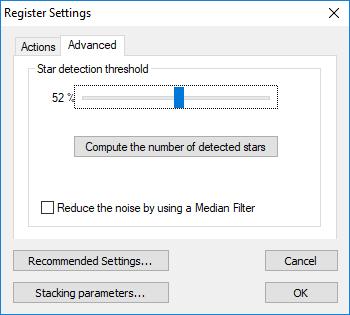
Clicking the comet button in DSS, I could see that lots of stars were shown where there were none. Due to the hazy, light polluted sky and the short exposures, resulting in low signal levels, DSS was adding stars where there were none, effectively a lot of the background noise was being marked as the position of a star. So Deep Sky Stacker was stacking on noise in each image, not the stars.
I managed to get these images stacked by using the comet stacking method. I marked a real star as a position of a comet in each image prior to stacking them. This ensured the stars themselves were registered correctly.
Now the dark nights are here, and I’ll have more time to get out there and try more imaging, hopefully it won’t be long before I finally round the top of this new steep learning curve. I’ll then, once again, be back onto more familiar territory and be sent merrily back on my way happily imaging in one-shot colour.
Once I’m happy with this setup, I’ll then go back to Sharpcap to make sure that I get the most from my Pro license.
Of course, I’m always happy to learn from other people’s experience, so if you have a great workflow for the Altair 183C Hypercam, and know a better way of doing all of this, please let me know.
Dave
My free monthly sky diary for October 2018 showing the events of the night sky visible from the UK is now available in pdf form to download and print.
Click here, or on the image below to download the pdf.
I also have a sky diary to share on Google calendars.
Click here to go to my Google calendar.
More sky events will be added to the live Google calendar as more information becomes available.
You would think with running my imaging workshops, I knew a lot about astrophotography. Well, I think I do, but there’s nothing like getting a new piece of gear to bring you down a peg or two. You suddenly realise that despite all that knowledge packed in that old noddle, there’s still a flipping heck of a lot more you really don’t know anything at all about.
After purchasing the C11, I still had enough in my observatory pot to purchase a one-shot colour camera. Tri-colour imaging with a mono camera is great, but, let’s face it, it’s a real faff. A lot of the time you want something quicker and easier.
Having played with an Altair 183C Hypercam last year, and processed some images with it, this seemed to fit the bill quite nicely. It was very sensitive, easy to use and more importantly was reasonably affordable, and well within my budget.
So having made my decision, the purchase was made and I received this very nice looking camera. Trouble is, after it arrived, our house move very quickly descended upon us. Apart from a few Jupiter and Saturn images using the C11, which were extremely successful, the camera quickly went onto the back burner.
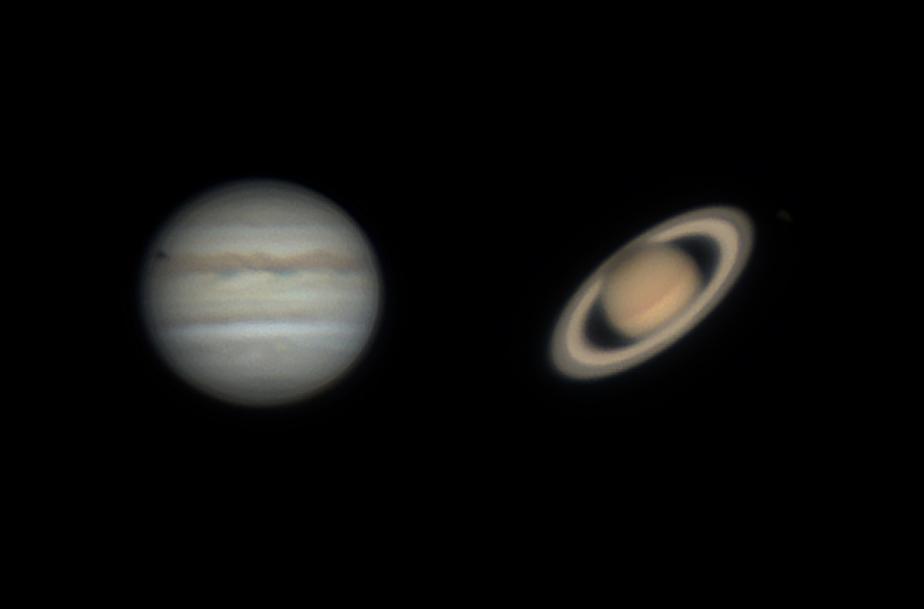

After moving, it took quite a number of weeks before I finally got my telescope pier installed. In the few times that circumstances and the weather actually allowed me to get out to experiment, I very quickly got extremely frustrated with the camera. Imaging with it, this time was really challenging. Stacking images was a nightmare. Could I get any colour in my images? No way! There was obviously much more to take into account when operating this camera than I had anticipated.
Comet 21P and The Dumbbell Nebula, but in only produced monochrome images when stacked. So frustrating. Whatever file format I used, it made no difference to the result.
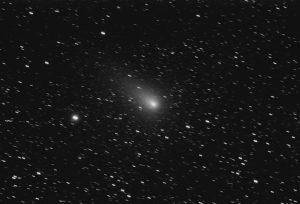

Hours of Googling and trawling the astronomy forums gave me some snippets of what I might have been doing wrong. But there were no real solutions or tried and trusted workflows written out to help someone new like me to getting this camera up and running successfully.
I will be writing my own guide as soon as I get a chance, so watch this space.
(I’ll add the link to my guide here when I’ve done it).
So it was still going to be a case of lots of trial and error and that familiar steep learning curve, we all love so much.
First red herring was that you get a years Pro license for Sharpcap with the camera.
So I was using this to take my images.
I have since reverted back to the Altair Capture software. Simplifying this capture process now appears to be doing the trick. I’ll re-visit Sharpcap once I’m happy the camera is working as expected. I also found that I had to make some changes in Deep Sky Stacker so it handles the FITS files produced by the camera correctly and recognises the correct Bayer matrix to produce colour images.
on the 17th of September, I got back from my talk at Retford. Despite the skies having a lot of clag in the air, (the Milky Way was almost non-existent), as I had thought I had got my head around things, I decided the time was right to get out and see if I could produce some reasonable colour images.
And boy, this time the camera didn’t disappoint. Despite the bright sky background, some very faint stars were visible in the individual subs, and only 40 seconds exposure (I haven’t got my auto-guiding set back up again at this stage).
Later I found a problem registering the stars when I came to stack the images. This again was caused by the hazy background and the images being stacked on noise, rather than stars.
I finally gave up just after 3am, when thick clouds came over and hid things completely. It was nice to see Orion rising and catch up with Comet 21P, now in Gemini, again since Kelling.
Below are some of the results from that night.
If you want to see more images taken that night, go to my Flickr Site:
https://www.flickr.com/photos/eagleseyeonthesky
Now I just can’t wait for The Moon to get out of the way, so I can see just what this camera is really capable of.
NGC 7331 and the Deer Lick Group in Pegasus.

The nearby Stephans Quintet in Pegasus.
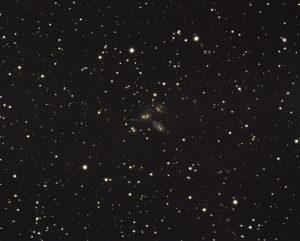
Comet 21P.

M42, The Great Orion Nebula.
Composite image of 3 separate images produced from 3 different sub-exposures.
10, 20 and 30 second.
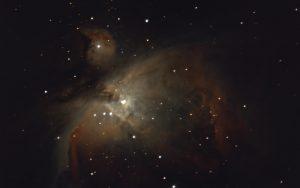
Tonight I will be presenting to Retford & District Photographic Society
I will be giving them my Finding your way around the night sky and starting out in Astrophotography presentation.
Hopefully, we’ll get more people out there, enjoying and imaging the night sky.
The Society meets at 7.30pm.
Venue:
St Joseph’s R.C. Church Hall,
Babworth Road,
Retford,
Notts.
DN22 7BP


On Friday the 14th of September I will be once again re-visiting Coventry and Warwicks Astronomical Society.
This time I will be presenting The History of Manned Space Flight, The Space Race, between The USA and Russia, which resulted in the magnificent Apollo lunar landings between 1969 and 1972.
I am really looking forward to seeing them all again.
Their meetings start at 7:15pm.
Venue:
Earlsdon Methodist Church Hall,
Earlsdon Road South,
Earlsdon,
Coventry,
CV5 6NF
The darker skies of Kelling Heath and Loughton Astronomical Society’s annual Autumn Kelling Skycamp are calling.
Well, it is that time of year once again.
Towards the end of this week, and over this weekend, for the main event, hundreds of astronomical-minded folks will be gathering in North Norfolk at this much anticipated annual event. I feel that Kelling starts the years observing season off with a real bang.
It’s a great sociable event, so don’t let the current weather cloud forecast put you from coming along. If it does clear, there’s the chance to see some really dark skies, and look through some huge telescopes people bring along. Or just sit outside the tent with a glass (or a hot cuppa) in your hand and sit underneath the stars and take it all in.
I’ll look forward once again catching up with some of my very good friends and if you’re coming along, come and find me to say “Hello”.
I might even have some of my books with me to sell too. 😉
So, here’s to another great weekend of astronomy (With a fair bit of socialising added in).
Dave
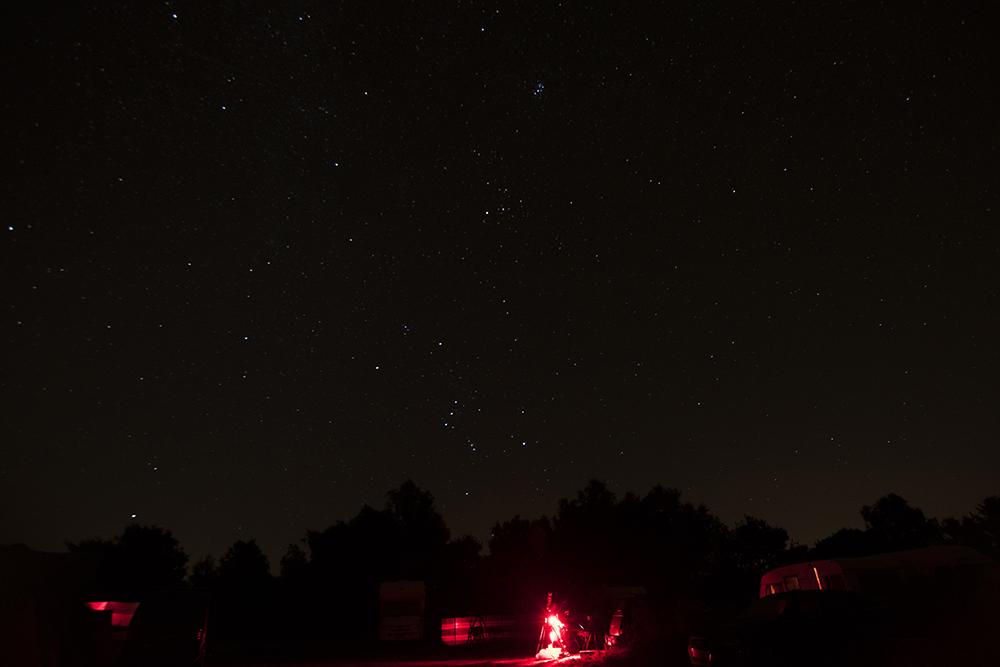
My free monthly sky diary for September 2018 showing the events of the night sky visible from the UK is now available in pdf form to download and print.
Click here, or on the image below to download the pdf.
I also have a sky diary to share on Google calendars.
Click here to go to my Google calendar.
More sky events will be added to the live Google calendar as more information becomes available.

The Federation of Astronomical Societies is holding it’s annual AGM and convention.
Click on the white text above for more details.
This year it is being held at The University of York on the 22nd of September.
Starting at 9:00am after a short AGM, a whole day of astronomy goodness awaits.
There’s a great line up of speakers for the day:
There will also be a number of trade stands, including yours truly.
So come along, say “Hi” and feel and sniff comet 67P.
Tickets are £6 for members of Affiliated Astronomical Societies, or £8 if not.
Book your tickets for the FAS Convention by Clicking Here.
Imaging comets offers many challenges over deep sky objects.
Deep sky objects stay still relative to the stars, so as long as you are tracking the sky OK, they will show lots of details on long exposures. Comets are notoriously difficult, especially when they are approaching perihelion (the closest point to the Sun), when they are moving at their quickest in their orbit, or relatively close to Earth, when their perceived motion is at its greatest.
When these two circumstances coincide, the comet appears to be really shifting against the background stars from Earth. So unless the imagers telescope can be tracked on the comets motion, details in the comets tails or coma will quickly blur as the motion of the comet smears it across the image.
The animation below shows the motion of Comet 21P / Giacobini-Zinner on the 16th of August. Click here for my guide to viewing Comet 21P.
This was produced using 40 second subs, taken immediately after one another. You can quite clearly see how quickly this comet is shifting between each exposure.

There are ways and means around this to make sure that the image shows maximum detail. The computer can be set to follow a set track in the sky, or, if the comets pseudo-nucleus is bright enough, auto-guide on the comet itself.
When these techniques are used, images of the comet are superb.
Below are two images of Comet C/2013 US10 / Catalina I took on the morning of the 21st of December 2015. This was a very fast moving comet.

But not all imagers are as well advanced as this, or the comet isn’t bright enough to guide on. So how can they cope with this movement?
The answer lies in reducing the exposure of individual subs taken of the comet.
In really fast moving comets, like Comet Catalina above, despite the pseudo-nucleus in this case being bright enough to auto-guide on, the comets movement was so quick, that I had to keep each exposures below 15 seconds each, to prevent the comet blurring. Each sub-image was taken one after the other. I kept imaging the the comet for over two hours before the sky started to brighten as dawn approached.
You would have thought that catching over two hours of data would have given me a superb image when all these subs were stacked together. Not So!
Have a look at the two Catalina Images shown above again. These are stacks of images taken about an hour apart. Look at the detail in the straight ion tail, pointing towards the right hand side of the image. There is a disconnection event visible in the first image, and this “ripple” was seen to move down the ion tail over the two hours as shown in my animation below.

Had I stacked all the images over the two hours, any detail in the ion tail would have smudged itself out of existence and been completely lost, due to its movement. So to produce the individual images in this animation, I had to effectively stack a small selection of subs from different time frames throughout the imaging period to produce my final series of images.
So, the two key points to take away from this is:
If the comet is moving fast, and the comet is too faint to guide on, use short exposures to reduce the movement of the comet during each exposure.
If imaging the comet for an extended period, do not be tempted to stack all the images over that time as any detail will blur itself out.
You should then end up with something that starts looking something like this.
Comet C2014 Q2 / Lovejoy – 6th February 2015.

So, we moved home on the 4th of July.
Much as I hate the way US traditions are infiltrating British culture, this date meant that due to us downsizing the house, we were no longer bounded by me having to go to work.
That day really was Independence Day for the Eagle household.
So after a frantic 6 and a bit weeks of having trades in the house, I have finally been able to get the “observatory” up and running.
After selling the dome, I had a set budget for my new setup. I would invest this money wisely, to try and upgrade some instrumentation, if possible.
So instead of a dome or roll-off roof, I opted to cement my pier in the chosen location in the garden and erect an off-the-shelf shed nearby, which would eventually have power connected to it. This reduced the costs of my new observing facilities significantly.
So, by making this change, as part of my upgrade, I managed to get a Celestron C11 at a very good cost, and still had enough left in the budget to purchase an Altair Astro 183C Hypercam.
So I’ve got a new camera. Not for the first time, I find myself once again on that very steep learning curve.
How does the camera work? What are the best settings to use?
On the evening of the 16th of August, the skies looked like they were going to be clear after a cold front went across bringing rain that morning. The pier was set up, so I ran an extension lead out for power and connected the computer to the mount. A quick port change and everything talked perfectly as if it had never moved from the observatory. As the sky started darkening, I took a quick look at the Moon, capturing a quick series of images using the Hypercam before it slipped behind the neighbours house.
Not bad considering the sky wasn’t even dark at this time and shows the field of view obtained with this camera when used with my 190 Mak-Newt.

As the sky darkened further I focussed on a bright star using the Bahtinov Mask. If you haven’t got one of these brilliant devices, how long does it take you to focus the camera properly? So first plan was to go capture a comet.
So, I slew the scope over to Comet 21P /Giacobini-Zinner, visible in the north eastern sky. This comet has been very bright lately, as it approaches perihelion.
Click here to read my guide to this apparition of Comet 21P.
I took quite a number of images saving as all different formats to see if I can tweak an image out. It was a real challenge. Initial images looked fine on the screen, but when I came to stack the images using my trusty software Deep Sky Stacker the images were blurred. The stars, despite many being detected, the images just would not stack.
I even went over to M13, a big bright object, to see if this would help.
The same thing happened.
I finally got tired and packed up at 1am.
So the next day, a few lengthy manual image processing sessions started to try and retrieve some images from all the data I had collected. The results are still monochrome, so there’s something I’m still not doing right.
Comet 21P – Subs manually stacked and processed in Photoshop.

M13 – Subs manually stacked and processed in Photoshop. (The Propeller is nicely visible).
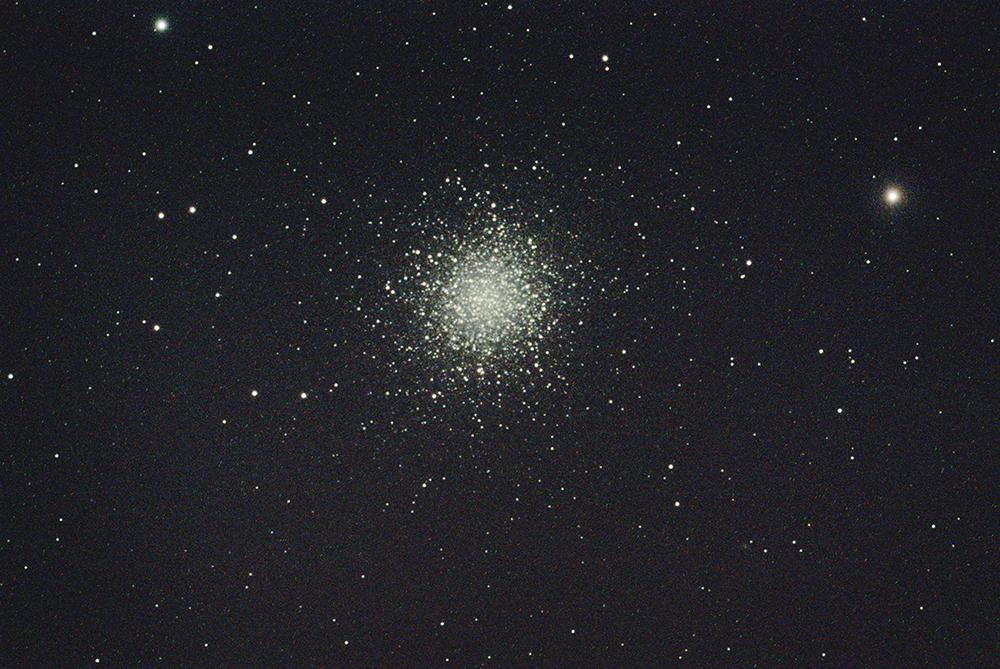
I finally found 5x 40 second subs saved in FITS format that would stack correctly. Still no colour to speak of, but hey, it’s a start. Despite being only a total of just over 3 minutes integration time, there are some faint stars showing up there and some nice structure in the head of the comet. So the initial results are starting to show the potential of this camera.
Onwards and upward… Here’s to next time.
